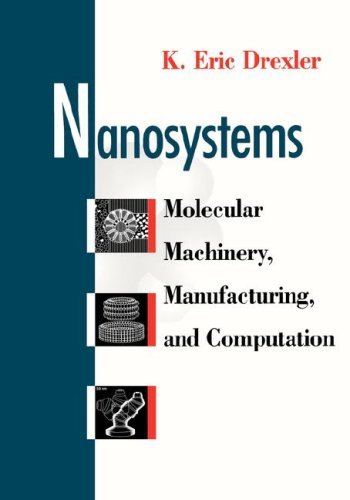Nanosystems

Nanosystems: Molecular Machinery, Manufacturing, and Computation - by K. Eric Drexler
"Nanosystems" [1]
is the main technical reference book for feasibility analysis of the far term target of atomically precise manufacturing.
This far term target being gemstone based metamaterial technology.
The book is for the most part:
- an identification of a sensible far-term-target technology
- a stringently conducted feasibility study of this target technology
Only the very last chapter touches briefly and incompletely on eventual approaches that could be part of some pathways towards that target technology.
What you can and can't gain from reading Nanosystems
Here's what you can gain from reading Nanosystems
(and maybe for the first pass jumping over difficult parts to get the big picture quickly)
- The technical reasons for why diamondoid nanofactories seem like an ideal far-term-target.
- Or reversely: A (highly conservative) feasibility analysis of diamondoid technology.
So in case you are doubtful about the feasibility of the far-the-target or
just want to understand the technical reasons for the far-term-target
then Nanosystems is for you.
Here's what you can NOT gain from reading Nanosystems
- Detailed information/analysis of possible bootstrapping pathways.
There's only a superficial bit on the incremental path at the very end. - Discussion of gemstone based mechanical metamaterials as basis for future products.
- Ideas regarding the amazing stuff will be possible with these kinds of metamaterials as new technological basis. Consult the work of the futurist writer Josh Storrs Hall on that. That work is high level exploratory engineering. Much is much less reliable in predictions as they depend on many sub-predictions combinedly.
- Ideas on medical nanodevices: Consult Robert Freitas Nandemedicine series for that.
- Any discussion of molecular assemblers as these are NOT identified as ideal far term target for three reasons.
Free to read dissertation preceding the Book
Eric Drexlers 1991 MIT dissertation is as he wrote
"a draft of Nanosystems" and was published by him for free to read.
Unfortunately his website is completely gone now (as of 2021-03).
But it's still available via internet archive (link below in external links section).
Note that some parts are missing in the dissertation compared to the book including (not an exhaustive list):
- Nanosystems 11.6 Electromechanical devices (page 333) including 11.7. DC motors and generators (page 336)
- The final Nanofactory analysis listing an example System Table 14.1 (page 422)
- ...
Still the only resource on the topic
Till day of last review of this text (2023) there is still no other book available that:
- is covering the same topic and
- is also stringently applying exploratory engineering
As the first and last book of its kind it leaves a huge amount of exploratory engineering work that needs to be done.
And as a book that does not focus on pathways it leaves even more there..
Important things to note
In the technical book Nanosystems "universal molecular assemblers" are neither proposed nor even mentioned!
Instead in the brief section about pathways at the end of the book the incremental pathway to "nanofactories" is discussed prominently.
Using biotech to get away from biotech ASAP.
The only topic in the book that may be somewhat related to universal molecular assemblers and their direct path context
is a discussion of pressure driven diamondoid actuators and from withing expandable modular plate or block vacuum sealing methods.
Why is this important?
In the preceding popular science book Engines of Creaton "universal molecular assemblers" where discussed. See: Molecular assembler.
This lead to some hype, fear, and negative influence on relevant funding. As discussed in the newest popular science book on the topic: Radical Abundance.
Molecular assemblers are absent from nanosystems not for political reasons but for technical reasons.
One point of evidence being that the dissertation (1991) and book (1992) was published well before the problems manifested around 2000/2001.
This wiki is written independently by third party and thus
does not necessarily accurately describe the ideas of the author of Nanosystems.
Related
- Other Books By Erik K. Drexler.
- Macroscale style machinery at the nanoscale
- Why gemstone metamaterial technology should work in brief
- Concept animation Video summarizing the results of the book: Productive Nanosystems From molecules to superproducts
- Far term target: Gemstone metamaterial on chip factory which are part of and create more of gem-gum technology
- More generally: Advanced productive nanosystem
- More specifically: Design of gem-gum on-chip factories
- There's also: Discussion of proposed nanofactory designs
- Disambiguation page: Productive nanosystem (disambiguation)
- Theoretical overhang
External links
Nanosystems: Molecular Machinery, Manufacturing, and Computation
The whole book on the internet archive here (restricted access):
https://archive.org/details/nanosystemsmolec0000drex
Drexler_MIT_dissertation.pdf (unrestricted access)
- (recovered via interent archive wayback machine archive)
- Alternate link (faster)
- "Original link - now broken :("
On K. Eric Drexlers website (recovered via internet archive):
- Detailed table of contents and sample chapters
- Nanosystems: what it’s about, how it's used, and where to read more
- Nanosystems: Molecular Machinery, Manufacturing, and Computation
References
- ↑ Nanosystems: Molecular Machinery, Manufacturing, and Computation - by K. Eric Drexler (1992)